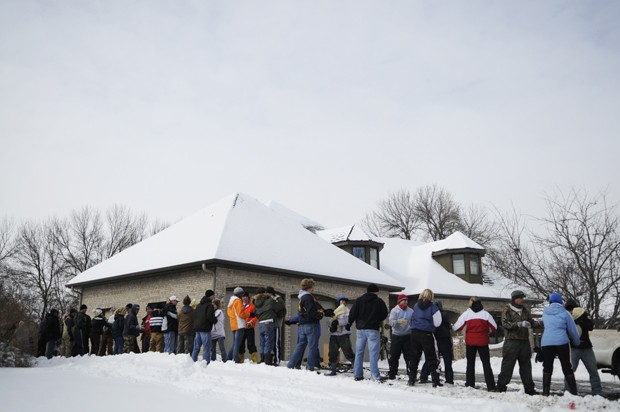MOORHEAD, MINN.– University first-year Michelle Schultz left Minneapolis at 6 a.m. Thursday on a bus with her sister, a Honeywell employee and Carlson School graduate student, and 30-some other Honeywell employees. By 10 a.m., Schultz was part of a long chain of people that stretched from the road, where volunteers had set up a makeshift sandbag-filling station, through the backyard of a south Moorhead home, and to the reinforced banks of the Red River. Filled sandbags were sent quickly down the line; it took one bag 47 seconds to pass through the hands of nearly 40 people to become part of the next layer of the barrier, which was raised to a height of 43 feet Thursday afternoon. Between the two sandbag- passing lines and the roadside bag-filling operation, at least 100 volunteers worked in freezing weather and falling snow around Mike SzymanskiâÄôs house that afternoon. âÄúA lot of times, people just show up,âÄù he said. He and his wife Edna, president of Minnesota State University-Moorhead, were supposed to be vacationing in Florida last week. But when forecasters started predicting a river crest of 40 feet, she decided theyâÄôd better stay in town. Though it was iffy at the time whether that was necessary, he said, it turned out to be a good choice.

The Szymanskis moved from Maine to Moorhead last June. Though heâÄôd expected flooding in his new home, Mike Szymanski said, he did not expect record-breakers. On the East Coast, he saw floods like this on the news, but experiencing it is totally different, he said. âÄúItâÄôs surreal,âÄù he said, looking out at the treetops that emerged from his submerged backyard. The riverâÄôs quick rise has amazed him, as has the community. On Sunday, he said, he and his neighbors were aided by volunteer churchgoers directed by their pastor, and he lauded the way his neighbors have taken on the task of organizing volunteers. In the past, when people asked about how he and his wife were adjusting to the Midwest, he said his answer used to be âÄúweâÄôre home.âÄù And this flood experience has only strengthened that, he said.

SzymanskiâÄôs neighbor Dick Lee has lived in his home on the Red River since 2002, he said, and this is the first time heâÄôs had to sandbag. Despite increasing crest predictions and a city suggestion that residents evacuate, Lee plans to beat the flood. âÄúWeâÄôre not leaving and weâÄôre not losing,âÄù he said. Still, crest predictions were upped again Thursday afternoon, and some people donâÄôt have much room to expand their barriers, one area resident said. They canâÄôt just pile more sandbags on top âÄî to be effective, the sandbag walls must be widened to support the additional height. Most volunteers had cleared out of that neighborhood by early evening, but there was no shortage later that night at Nemzak Hall, Minnesota State University-MoorheadâÄôs volunteer dispatch center. With classes canceled at the three major area colleges, many of the volunteer sandbaggers whoâÄôve pitched in this week are students. Katrina Brashers, a music education first-year at Concordia College, has been volunteering between four and eight hours daily since Sunday, she said, and pulled a 10-hour day Tuesday. Floods like this donâÄôt happen in her hometown of Colorado Springs, she said, and sheâÄôs been getting daily calls from her worried parents. ItâÄôs emotionally tough to see people homes being threatened, along with others who have already had to be rescued from submerged houses, she said. Concordia âÄî the closest of the three area colleges to the Red River — announced Thursday afternoon it was closing campus because of the flood, Brashers said. Neither she nor her roommate, Yuan Zhang, an exchange student from China, can easily get home, so theyâÄôll be staying at BrasherâÄôs fianceâÄôs off-campus home. Finance junior Zhang said before this year, sheâÄôd never seen a blizzard or a flood at all, much less simultaneously. She also said she was surprised at the student and citizen involvement in staving off the floodwaters. In China, she said, the government would likely dispatch its own forces to deal with it rather than asking communities to help. Though one volunteer had mentioned he planned to work into Friday morning, the dispatch center cleared out before midnight Thursday. Rising crest predictions and road closures made it unsafe for volunteers to be adding to sandbag barriers at night, said Angela Seewald-Marquardt, who was working at a registration table Thursday night, and area sandbag-filling centers were filled nearly to capacity with volunteers.








